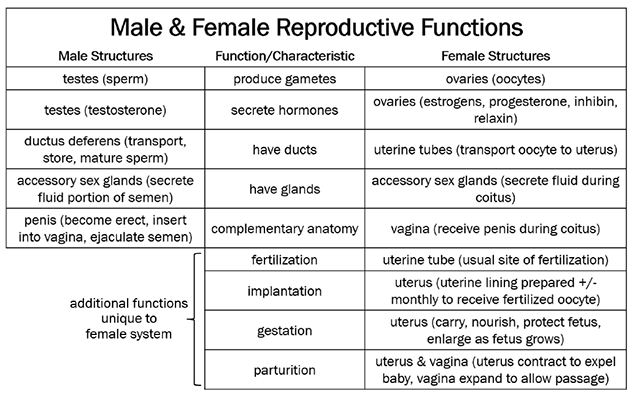Functions of the Reproductive System
Objective 1
Describe the general functions of the male and female reproductive systems.
Disclaimer
You are enrolled in a Health Sciences course which may include instruction in the anatomy and physiology of binary gender, reproduction, sexually transmitted diseases, birth control, and related topics. In addition, drawings, photos, and/or videos will be used in which genitalia (human sex organs) are visible. Discussions involving gender are to identify anatomical and/or physiological differences between male and female, as determined by the presence (male) or absence (female) of the Y-chromosome in all body cells. The Health Sciences Department presents this information in a professional manner. This course material is closely aligned with national guidelines and is required for all professionals in healthcare fields.
In any anatomy and/or physiology course, the reproductive system is almost always presented last. Some might wonder why this is so. While there could be several reasons, may I suggest two…
First, the reproductive system is the only body system that is completely different between male and female. The only other body system with a gender-related difference is a single item in the Renal (Urinary) System — the significant difference in the length of the urethra between females (short) and males (about five times longer than females). But even this difference is related to the fact that the male urethra is shared by the urinary and reproductive systems, while the female urethra is not (urinary system only).
Second, every body system we’ve already covered is vital to the survival of the organism. None of us can survive independently without a functioning integumentary, skeletal, muscular, nervous, endocrine, cardiovascular, immune, respiratory, digestive, and urinary system. Only the reproductive system is completely unnecessary for the survival of the individual organism. For the survival of the species, yes, it’s absolutely necessary, but not one of us depends on the reproductive system for our own, individual survival.
So, let’s move on to the functions of the reproductive system and the parts list of system organs and glands.

The reproductive system, both male and female, has the following properties:
- Produces gametes – specialized cells that, when combined, make another, unique human being
- Secretes hormones – maintain reproductive organs as well as other body systems
- Has ducts – for moving the gametes around
- Has glands – for semen composition and for lubrication to make coitus (the sex act) more pleasant
- Has complementary anatomy – coital partners are held together briefly for gamete transfer
In addition, the female reproductive system performs functions the male cannot:
- Fertilization – union of gametes, usually occurs in uterine tube
- Implantation – attachment of the embryo to the inside lining of the uterus
- Gestation – carry and nourish the developing fetus during growth and development
- Parturition – labor and delivery
We will first consider male reproductive anatomy, then female reproductive anatomy, then male reproductive physiology, then female reproductive physiology. Why male first? Because the male reproductive system is more simple and the female reproductive system is more complex, so let’s address the simple stuff first.
Media Attributions
- U20-001 Table of Reproductive Functions Male Female © Winterton, Brad is licensed under a CC BY-SA (Attribution ShareAlike) license

